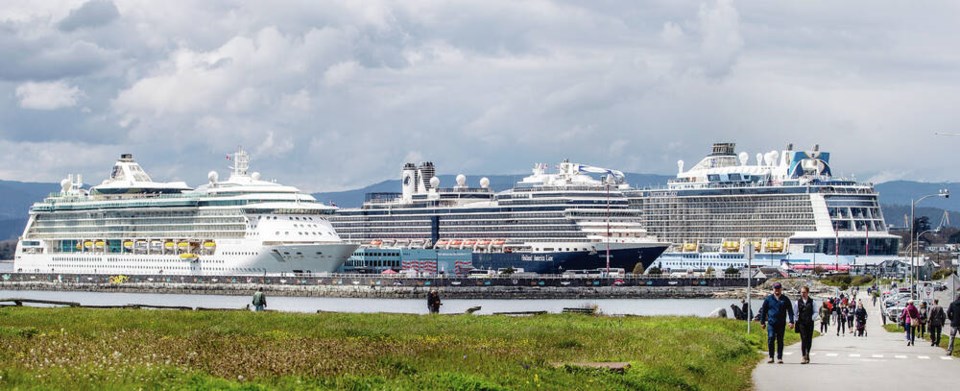A commentary by a James Bay resident.
The provincial government’s announcement that it will give $9 million (taxpayer) dollars to help finance shore power for cruise ships that dock in James Bay leaves those not familiar with this industry with a very incomplete picture of the situation and the effects of this industry on the James Bay neighbourhood, the entire city of Victoria, and the coastal waters around Vancouver Island.
It is undeniable that shore power would be better than the current situation where cruise ships spew bunker fuel fumes for hours at a time while they are docked. But here are some of the many unanswered questions:
• What is the timeline for installation of shore power? Once it is installed, will its use be mandatory? Will permission to dock be limited to those ships which are equipped to use shore power and will there be a requirement for its use by those ships?
Only half of the cruise ships which docked in Vancouver in 2019 were capable of connecting to shore power and only half of those so capable actually plugged in. The previous CEO of the Greater Victoria Harbour Authority society is on record as stating that he expected that it would be 2030 before 85 per cent of ships would be shore-power capable.
• Will shore power allow ships to completely power down, or only to power off some of the engines they need to run these massive vessels?
• What infrastructure will be required in James Bay for this project? James Bay, a very small geographic area, is already being crushed by development projects. This centre of tourism and city activity is being slowly, but surely, destroyed.
• Is government confident that sufficient electricity for residents will be available when there are suddenly 10,000 (give or take) more demands on the power grid with the arrival of two or three cruise ships?
• Why does Victoria allow solid waste collection from cruise ships when they are only a few hours away from their home port of Seattle?
Based on 2019 cruise ship numbers and reported amounts collected (by a Vancouver company) about 120,000 tons of cruise ship waste would have been collected over an eight-month period in that year. Some of this goes to Hartland. The destination of the remainder has not been established.
These garbage trucks cause more traffic and pollution for the already congested James Bay neighbourhood. The noisy garbage collection area is directly across Dallas Road from residences.
• What is the provincial government doing to pressure the federal government and the cruise ship companies with respect to halting the dumping of toxic substances into the ocean?
The eastern coastline of Vancouver Island, and the sea creatures of our coast, are being poisoned by such dumping, especially that of the highly toxic scrubber washwater. World Wildlife Fund reported in 2022 that the Scott Island Marine National Park, off the north-western tip of the Island, had the highest amount of pollution from cruise ship dumping of all Canadian Marine Protection Areas.
• And, crucially, will the numbers and sizes of cruise ships be limited in the future, given, for one thing, the overwhelming numbers of cruise ship passengers that are bussed, or otherwise travel, through the James Bay neighbourhood? Look to cities such as Venice and Barcelona (and Alaskan towns) for the devastating effects of over-tourism.
As far as the environment is concerned, just as an electric car is certainly better than a gas-powered one (if you need to buy a car), so too cruise ships connected to shore power are superior to ships which send tons of greenhouse gases into the air from their running engines.
But electric cars are not the answer to the environment crisis, and, in fact, create their own environmental and social issues. A reduction in the number of cars is the only thing that will help.
The aim for the provincial government must not be to facilitate the ever-increasing growth of a bloated cruise ship industry in this city — an industry which, according to an independent American economic report published in 2022, adds minimally to Victoria’s tourism dollars with non-cruise ship tourism being 20 times greater — but to limit numbers and sizes of the ships which dock here.
Only if shore power, together with such a reduction, is pursued can the province hope to gain any environmental credibility from this expensive project.
>>> To comment on this article, write a letter to the editor: [email protected]



